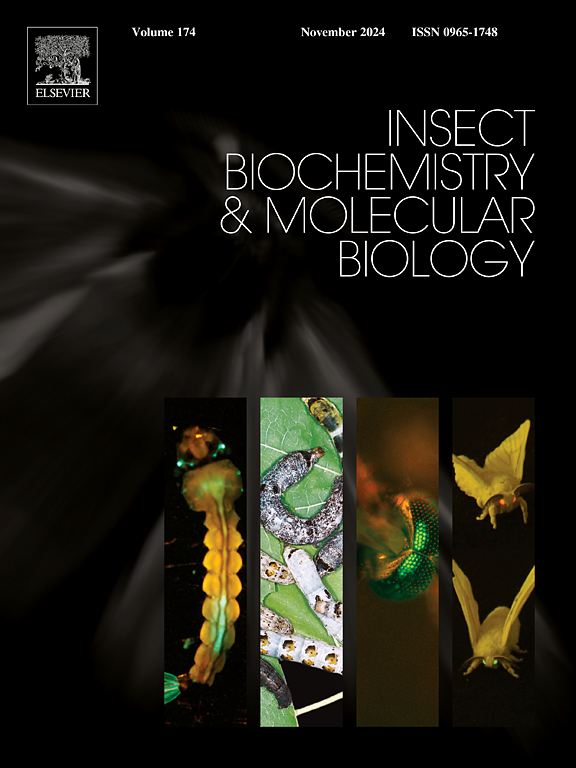Sex pheromone biosynthesis in the Oriental fruit moth Grapholita molesta involves Δ8 desaturation
IF 3.7
2区 农林科学
Q2 BIOCHEMISTRY & MOLECULAR BIOLOGY
引用次数: 0
Abstract
The Oriental fruit moth Grapholita molesta is distributed throughout temperate regions and considered to be a pest in peach production and other high-value fruit crops in the rose family. Insecticide treatment has led to resistance development, but the use of sex pheromones in pest management has shown great promise. We investigated the pheromone biosynthesis pathway in G. molesta with the aim of elucidating pheromone evolution in the Olethreutinae subfamily of moths and harnessing pathway genes in biotechnological production of sex pheromone for use in pest management. In vivo labelling experiments suggested that an uncommon Δ8 fatty acyl desaturase is involved in sex pheromone biosynthesis. CRISPR/Cas9 knock-out of the highly expressed candidate desaturase gene Gmol_CPRQ almost completely blocked the production of Δ8 pheromone components in vivo. Heterologous expression of Gmol_CPRQ protein in yeast- or Sf9 insect cells, however, failed to demonstrate the expected Δ8 desaturase activity. Instead, Δ9 desaturase activity was observed. Co-expression in the yeast system of the electron donor, cytochrome b5, from G. molesta still produced only Δ9 desaturase activity. We suggest that Gmol_CPRQ is intimately involved in pheromone production in vivo, via an unknown reaction mechanism that may possibly involve another co-factor that is absent in the yeast and Sf9 expression systems, or depend on its subcellular site of activity. Solving this puzzle will shed further light on pheromone biosynthesis in the family Tortricidae and will be required for successful biotechnological production of fatty acids and pheromones requiring Δ8 desaturation.

东方果蛾的性信息素生物合成涉及Δ8去饱和。
东方果蛾分布在温带地区,被认为是桃子生产和其他玫瑰科高价值水果作物的害虫。杀虫剂处理导致了抗药性的发展,但在害虫管理中使用性信息素显示出很大的希望。本文研究了蛾类信息素的生物合成途径,旨在阐明蛾类油蛾亚科信息素的进化过程,并利用途径基因进行性信息素的生物技术生产,为害虫防治提供依据。体内标记实验表明,一种不常见的Δ8脂肪酰基去饱和酶参与性信息素的生物合成。CRISPR/Cas9敲除高表达的候选去饱和酶基因Gmol_CPRQ几乎完全阻断了Δ8信息素成分在体内的产生。然而,Gmol_CPRQ蛋白在酵母或Sf9昆虫细胞中的异源表达未能表现出预期的Δ8去饱和酶活性。相反,观察到Δ9去饱和酶活性。电子供体细胞色素b5在酵母系统中的共表达仍然只产生Δ9去饱和酶活性。我们认为Gmol_CPRQ通过一种未知的反应机制密切参与了体内信息素的产生,这种反应机制可能涉及酵母和Sf9表达系统中缺失的另一种辅助因子,或者取决于其亚细胞活性位点。解决这一难题将进一步揭示龟科信息素的生物合成,并将为成功的生物技术生产脂肪酸和需要Δ8去饱和的信息素提供必要条件。
本文章由计算机程序翻译,如有差异,请以英文原文为准。
求助全文
约1分钟内获得全文
求助全文
来源期刊
CiteScore
7.40
自引率
5.30%
发文量
105
审稿时长
40 days
期刊介绍:
This international journal publishes original contributions and mini-reviews in the fields of insect biochemistry and insect molecular biology. Main areas of interest are neurochemistry, hormone and pheromone biochemistry, enzymes and metabolism, hormone action and gene regulation, gene characterization and structure, pharmacology, immunology and cell and tissue culture. Papers on the biochemistry and molecular biology of other groups of arthropods are published if of general interest to the readership. Technique papers will be considered for publication if they significantly advance the field of insect biochemistry and molecular biology in the opinion of the Editors and Editorial Board.

 求助内容:
求助内容: 应助结果提醒方式:
应助结果提醒方式:


